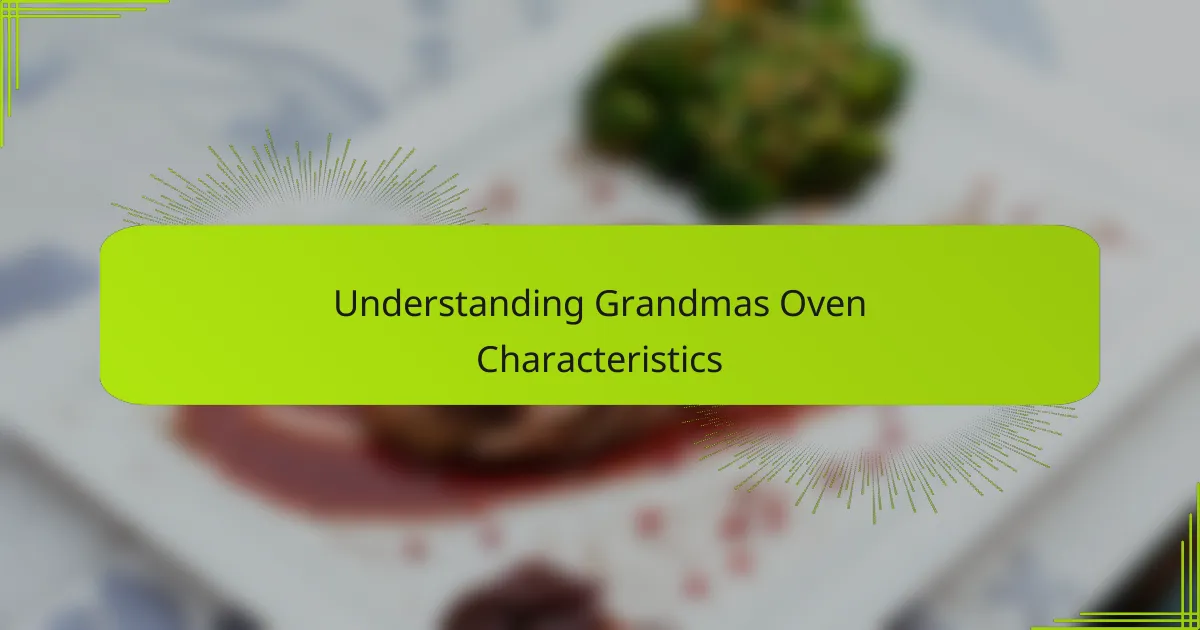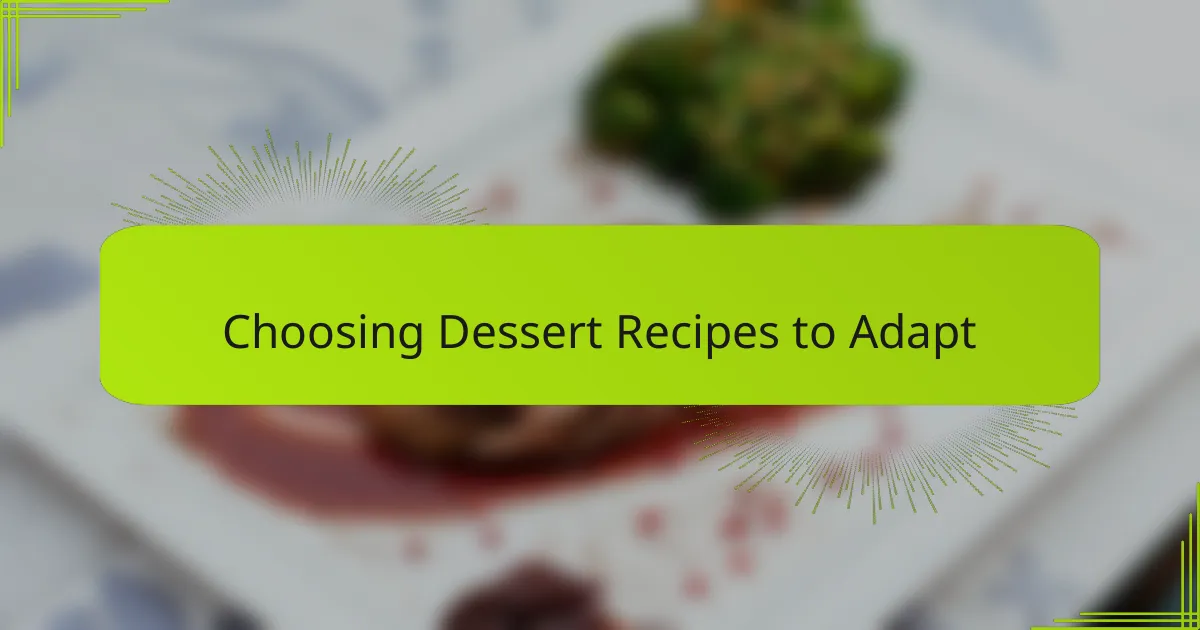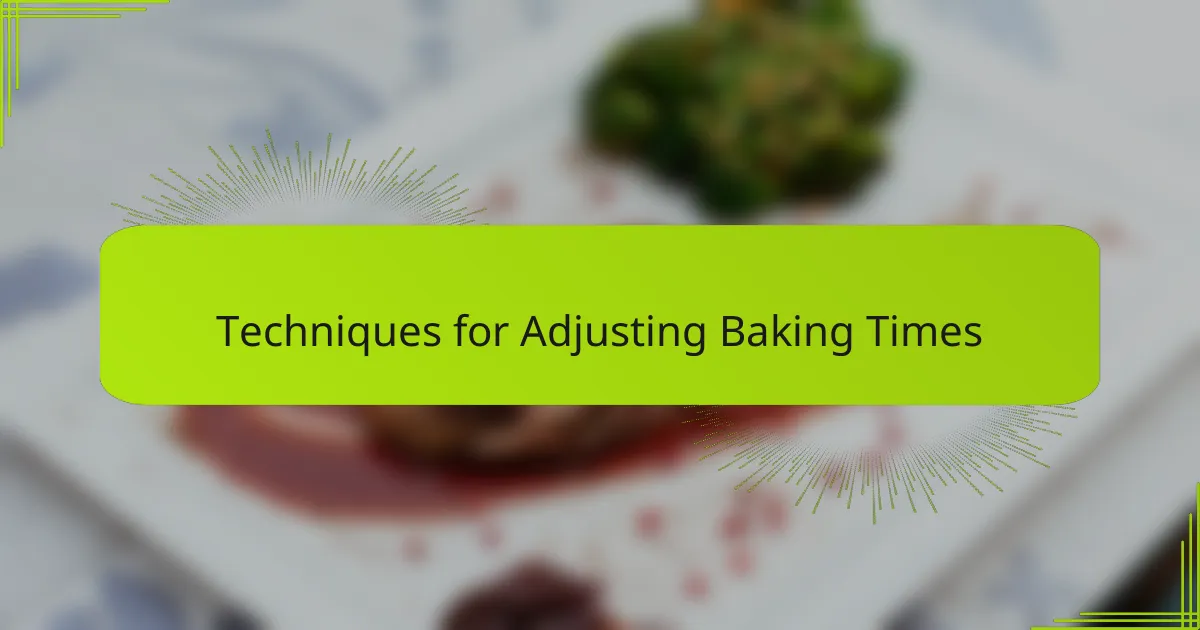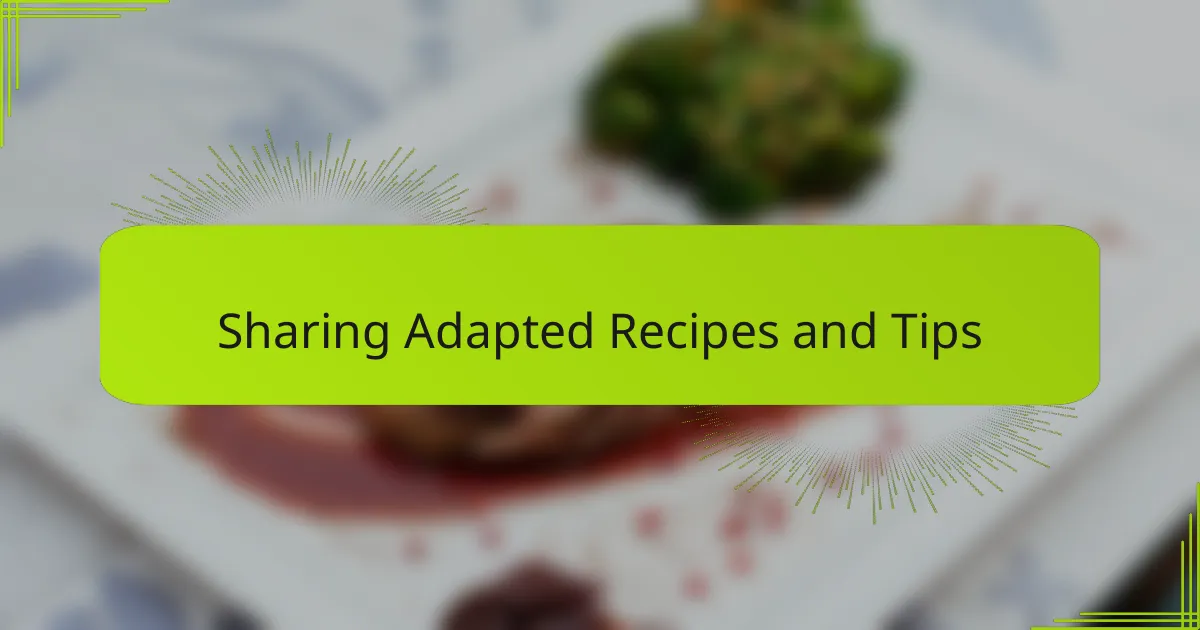Key takeaways
- Grandma’s oven requires a unique approach to baking, emphasizing intuition and sensory cues over strict time and temperature precision.
- Adapting dessert recipes involves embracing flexibility and rustic charm, allowing for personal touch and creativity while preserving traditional flavors.
- Modifying ingredients, such as adjusting sugar and moisture levels, can significantly enhance the outcomes of baked goods in an uneven heat environment.
- Sharing adapted recipes fosters a sense of community, encouraging experimentation and connection through the warmth of baking traditions.

Understanding Grandmas Oven Characteristics
Grandma’s oven always had a way of holding heat differently than the modern ones I’m used to. It feels like the warmth wraps around the dish gently, almost like a comforting hug, rather than blasting it from all sides. Have you ever noticed how a cake baked in such an oven has a distinct texture—soft inside but with a slightly crisp edge—that’s hard to replicate today?
One thing I quickly learned is that Grandma’s oven had hot spots, places where the heat was more intense. Baking anything in it meant sometimes rotating the pans or adjusting the oven rack height to get an even bake. It’s almost like you need to develop a sort of sixth sense about where the heat really lives inside that old oven.
I remember the smell—something smoky and homely—that would fill the kitchen whenever the oven was on. That aroma not only influenced the taste but also made the whole baking experience feel special and connected to generations past. Can a modern oven ever truly capture that same soulful warmth? I’m still not convinced.

Choosing Dessert Recipes to Adapt
Choosing which dessert recipes to adapt for Grandma’s oven quickly became an art in itself. I found myself leaning toward classics—think fruit crisps or dense pound cakes—that seemed to thrive in that gentle, uneven heat. Isn’t it interesting how some recipes actually blossom under these old-fashioned conditions, while others just don’t hold up?
I also discovered that desserts requiring precise temperature control, like delicate soufflés, were trickier to master. It made me appreciate recipes that embraced imperfection, the kind that welcome a little rustic charm. Have you ever noticed how some dishes taste better when they’re a bit “homemade” in the true sense, with those subtle quirks and textures?
Over time, I began choosing recipes based on their flexibility rather than strict instructions. For example, a simple apple crisp allowed me to play with baking times and rack positions without worrying about ruining the dessert. That freedom reminded me why Grandma’s kitchen was always a place of joyful experimentation and love.

Techniques for Adjusting Baking Times
Adjusting baking times in Grandma’s oven quickly became a bit of a guessing game that I actually came to enjoy. I learned to trust the visual cues more than the clock—watching for that golden crust or the smell that starts to fill the kitchen—because the oven’s heat was never quite consistent. Have you ever found yourself relying on your senses rather than timers? That’s exactly what I did here.
Sometimes, I had to extend baking times by 5 or 10 minutes because the oven heat was gentler and took longer to do its magic. Other times, quick rotations or shifting the rack halfway through would speed things up, ensuring my desserts didn’t dry out or burn on one side. It felt like choreographing a little dance between heat and time, a delicate balance I hadn’t experienced with my modern oven.
I remember one batch of brownies that took nearly twice as long as the recipe suggested, yet the result was nothing short of perfect—fudgy in the center with just the right crust on top. That taught me an important lesson: adapting is about patience and observation, not rigid adherence to times. Isn’t there something deeply satisfying about baking this way, more connected to the rhythms of the oven and the moment?

Modifying Ingredients for Better Results
Modifying ingredients became a key part of my baking journey with Grandma’s oven. For instance, sometimes I reduced the sugar slightly because the oven’s slow, enveloping heat caramelized the sugars more intensely, resulting in a deeper sweetness than expected. Have you ever noticed how a small change in sugar can transform the entire flavor profile, especially in old-fashioned baking?
I also found that adjusting fat content made a huge difference. Using a bit more butter or swapping in cream instead of milk helped mimic the richness that Grandma’s oven seemed to coax out naturally over longer, gentler bakes. It felt like the oven was coaxing flavors to develop slowly, so the ingredients had to be ready to respond to that tender heat.
Another tweak I made was to increase the moisture in some recipes, like adding an extra egg or a splash more liquid. That seemed to prevent dryness, especially since the heat was uneven and sometimes harsher in certain spots. Have you ever had a dessert that looked perfect but ended up a little dry? That’s exactly why balancing moisture became my secret weapon for better results.

Personalizing Classic Dessert Recipes
Personalizing classic dessert recipes with Grandma’s oven became an intimate dance between tradition and creativity. I realized that tweaking familiar flavors—like adding a pinch of cinnamon to a simple apple crisp or swapping nuts for dried fruit—could make these time-honored treats feel uniquely mine. Isn’t it amazing how small changes breathe new life into recipes that have been passed down for generations?
I often found myself asking: How much can I stretch a recipe before it loses its original charm? The answer, I discovered, was that honoring the soul of the dessert while bending the rules just enough creates a perfect balance of nostalgia and innovation. That balance turns baking into a personal story rather than just following instructions.
Sometimes, personalization meant embracing imperfections—those little cracks on a pie crust or uneven browning on a cobbler top—that gave the dessert character and warmth. Don’t those quirks feel like the signature of a recipe that’s been lovingly adapted and truly lived in? Those beautiful “flaws” made each dessert memorable and deeply satisfying to me.

Troubleshooting Common Baking Issues
Baking in Grandma’s oven sometimes meant dealing with uneven cooking—one side would brown faster while the other lagged behind. I quickly learned that rotating my pans halfway through was not just a suggestion but a necessity to avoid those burnt edges and undercooked centers. Have you ever had to pause mid-bake just to save a dessert from disaster? That’s the kind of hands-on attention this oven demands.
Sometimes, I faced the dreaded soggy bottom or a dessert that just wouldn’t set properly. I realized that increasing the baking time or lowering the temperature slightly helped me coax the right texture out without rushing the process. It felt like tuning into the oven’s mood, adjusting patiently until it hit that sweet spot.
And then there was the mysterious case of over-browning before the inside was done. It took several tries, but I found that placing the dessert on a lower rack or shielding it lightly with foil prevented that premature crust. Have you noticed how such small tweaks can make a world of difference? It’s all about listening closely to your oven’s unique signals.

Sharing Adapted Recipes and Tips
Sharing these adapted recipes and tips felt like passing along little secrets from Grandma’s kitchen, only with a modern twist. I found that writing down exactly how I shifted baking times or tweaked ingredients helped me remember what really worked—and made it easier to share with friends who wanted to try baking in an old oven too. Have you ever noticed how transforming a recipe can turn into a shared adventure rather than just following steps?
One thing I love about sharing these adaptations is hearing back from others who tried them and added their own touches. It’s like creating a community around the quirks of this oven, where every success and lesson learned becomes part of the story. Isn’t it amazing how a simple recipe can grow richer with every person who makes it their own?
Whenever I share these tips, I always encourage others to trust their senses and embrace those little imperfections. After all, isn’t that what baking in Grandma’s oven is really about? It’s not just about precise measurements but the warmth, patience, and creativity that turn a dessert into something truly memorable.




